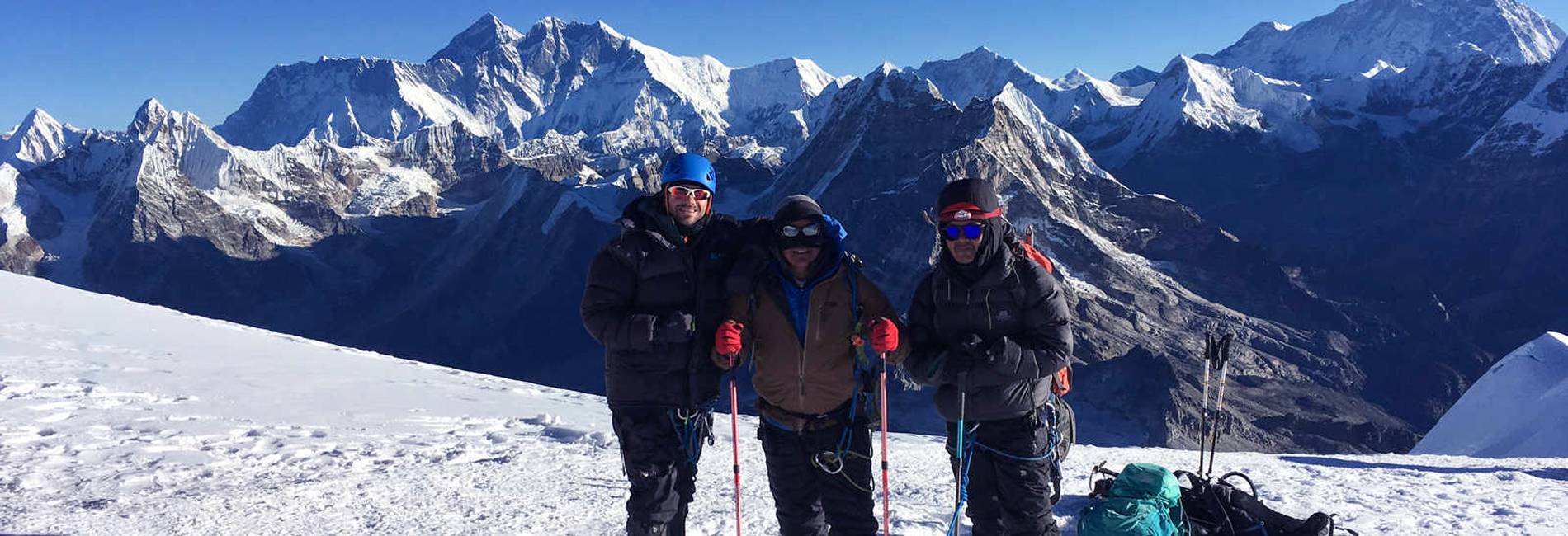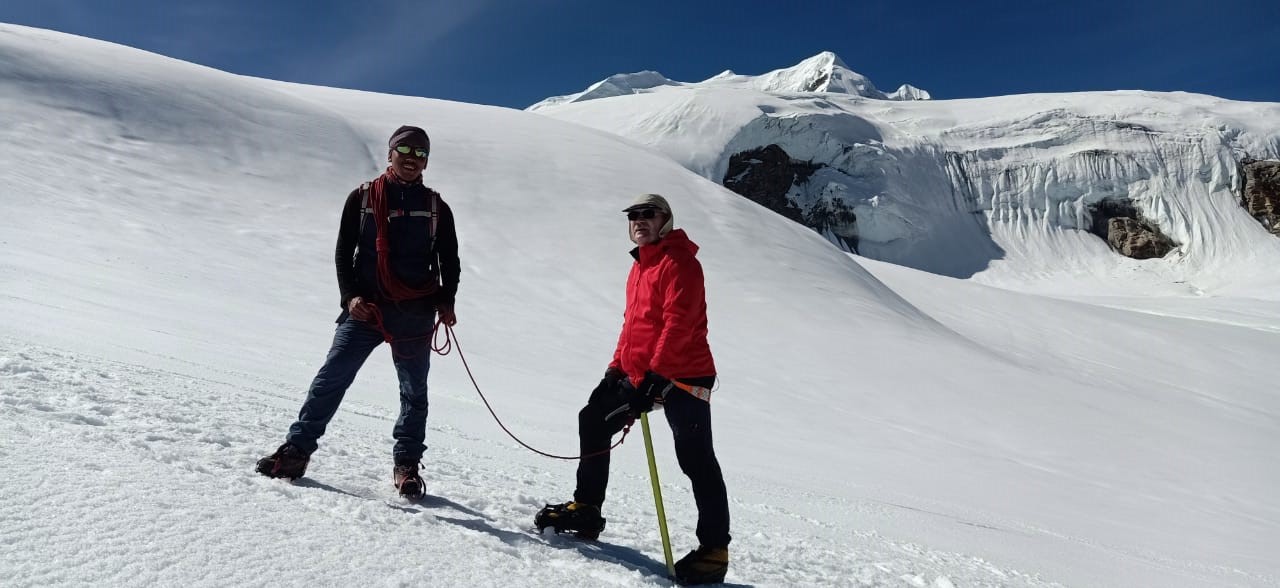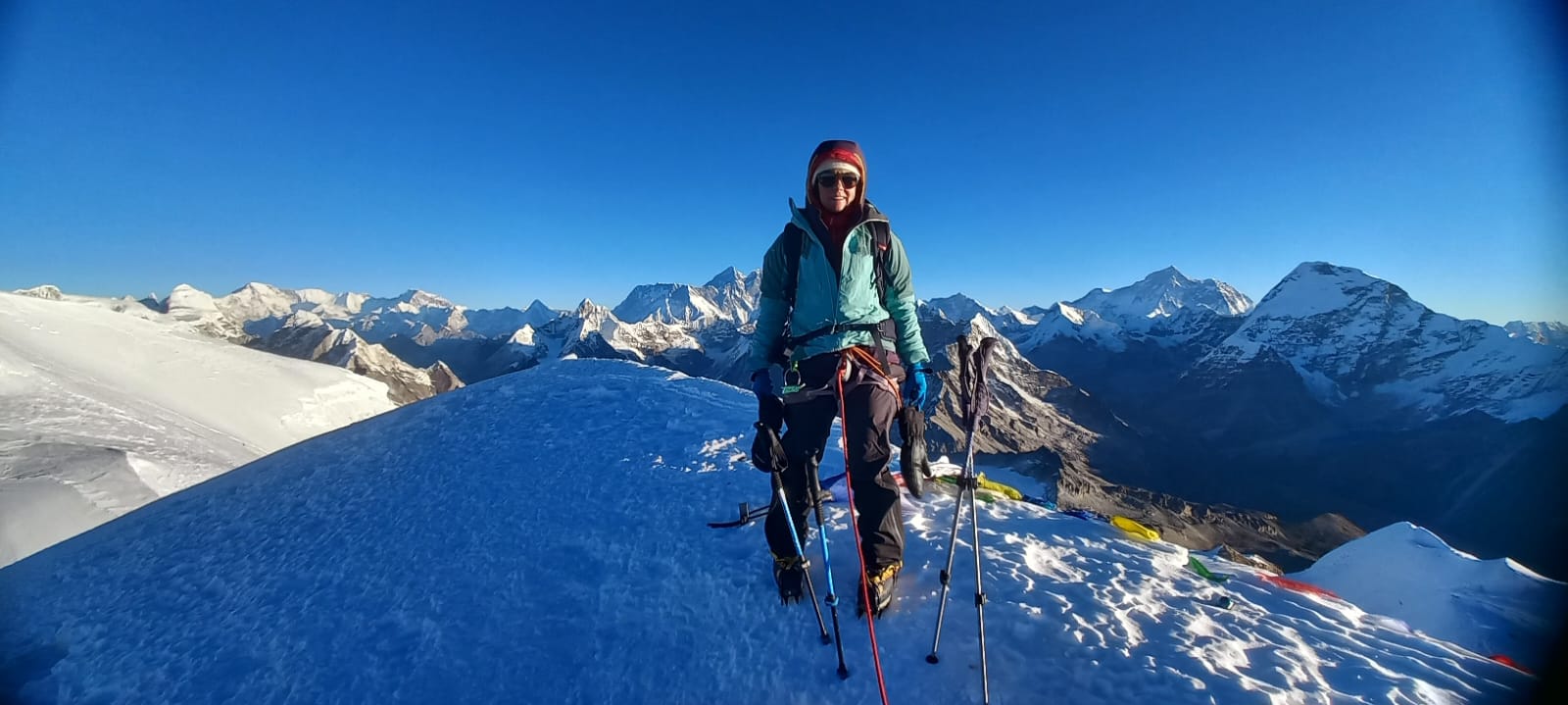26th August, 2025

Feb 18, 2024
Mera Peak Climbing in May
- Why Mera Peak Climbing In May Is Good
- Mera Peak Climbing In May Weather, Temperature, and Climate
- Mera Peak Climbing In May Difficulties
- Food, Accommodation, Guide, and Permit for Mera Peak
- What Should I Pack for Mera Peak Climb in May
- How Can I Choose the Best Climbing Company
- Beginner Climbers Suitable to Climb Mera Peak
- Successful Tips for Summiting Mera Peak
- Summit Success Rate of Mera Peak
- Is Mera Peak Technical
- Conclusion
- Mera Peak Climbing Packages
Climbing Mera Peak in May offers an exhilarating adventure amidst favorable weather conditions and breathtaking Himalayan landscapes. May marks the tail end of the peak climbing season in Nepal, making it an excellent time to embark on this journey to Nepal's highest trekking peak at 6,476 meters (21,247 feet).
During May, climbers can expect stable weather with clear skies and mild temperatures during the day, although nights can still be cold at higher altitudes. These conditions provide optimal visibility for enjoying panoramic views of Everest, Lhotse, Makalu, and other surrounding peaks from the summit of Mera Peak.
The trek to Mera Peak in May typically begins with a scenic flight from Kathmandu to Lukla, followed by a trek through the beautiful Hinku Valley. This route is adorned with blooming rhododendrons and other alpine flora, enhancing the scenic beauty of the journey. Along the way, trekkers pass through Sherpa villages, providing cultural insights and opportunities to experience local hospitality.

MERA PEAK CLIMBING
Mera Peak Climbing is an exhilarating adventure in Nepal that gives you an opportunity to reach the summit of Mera Peak at more than 6400m above sea level. Actually, it is the highest climbing (w...
Climbing Mera Peak involves crossing glaciers, navigating crevasses, and making a final ascent up a steep snow slope to reach the summit. The stable weather conditions in May contribute to safer and more predictable climbing conditions on the mountain, making it an ideal time for both novice and experienced climbers to attempt the ascent.
Overall, climbing Mera Peak in May promises an unforgettable adventure filled with natural beauty, cultural immersion, and the thrill of conquering a Himalayan summit. Whether you're seeking stunning mountain vistas, cultural experiences, or a personal challenge, May offers an optimal window to embark on this epic journey to Mera Peak.
Why Mera Peak Climbing In May Is Good
Climbing Mera Peak in May offers several advantages that make it a favorable time for mountaineers and adventurers. May marks the end of the peak climbing season in Nepal, providing optimal weather conditions and stable temperatures for summiting Mera Peak, standing at 6,476 meters (21,247 feet).
One of the primary reasons May is ideal for climbing Mera Peak is the stable weather. Climbers can expect clear skies and mild temperatures during the day, creating excellent visibility for panoramic views of Everest, Lhotse, Makalu, and other surrounding peaks from the summit. The weather conditions in May also contribute to safer and more predictable climbing conditions on the mountain, reducing the risk of storms and adverse weather events.
Additionally, May offers quieter trails compared to earlier peak months like April, allowing climbers to enjoy a more peaceful and less crowded experience along the trekking route. The Hinku Valley, adorned with blooming rhododendrons and lush vegetation, adds to the scenic beauty and charm of the journey.
Overall, climbing Mera Peak in May combines favorable weather, stunning scenery, and fewer crowds, providing an ideal opportunity for climbers to embark on a memorable Himalayan adventure.

MERA PEAK SUMMIT 10 DAYS
This is a chance to go climbing without the necessary permits that most climbing expeditions require in Nepal. Mera Peak fits the bill perfectly and at (6,476m/21,190ft) you will have spectacular view...
Mera Peak Climbing In May Weather, Temperature, and Climate
Climbing Mera Peak in May presents climbers with favorable weather conditions and a mild climate conducive to mountaineering. May marks the transition from Nepal's spring season into early summer, characterized by stable weather patterns and clear skies.
During May, climbers can expect daytime temperatures to range from mild to moderately cool, depending on altitude. In lower regions and during sunny days, temperatures can be pleasant, while higher altitudes may experience cooler temperatures, especially in the early mornings and evenings. Nighttime temperatures at base camps and high camps can drop below freezing, requiring adequate cold-weather gear for warmth and comfort.
The stable weather conditions in May contribute to optimal visibility for enjoying panoramic views of the Himalayan peaks, including Everest, Lhotse, and Makalu, from Mera Peak's summit. Clear skies and minimal precipitation enhance the climbing experience, allowing for safer and more enjoyable ascents and descents.
Climbers should be prepared for varying weather conditions and temperature changes throughout the day by layering clothing and carrying essential gear such as waterproof outerwear, insulated jackets, and warm accessories. Proper preparation and monitoring of weather forecasts ensure climbers are equipped to handle the climate challenges of climbing Mera Peak in May.
Mera Peak Climbing In May Difficulties
Despite the favorable weather conditions, climbing Mera Peak in May presents several challenges that climbers should be prepared to navigate:
- Altitude: Mera Peak stands at 6,476 meters (21,247 feet), requiring climbers to acclimatize properly to avoid altitude-related illnesses such as acute mountain sickness (AMS). Gradual ascent and acclimatization days are essential for adapting to the thin air at high altitudes.
- Glacier Crossings: The ascent to Mera Peak involves navigating glaciers and crossing crevasses, which requires careful route planning, use of mountaineering equipment (crampons, ice axes), and knowledge of glacier travel techniques.
- Weather Variability: While May generally offers stable weather conditions, climbers should be prepared for sudden weather changes, including high winds, snowfall, and potential storms. Monitoring weather forecasts and being flexible with climbing schedules are crucial for safety.
- Physical Demands: Climbing Mera Peak is physically demanding, requiring good cardiovascular fitness, strength, and endurance. Training in advance with hikes, cardio exercises, and strength training prepares climbers for the rigors of high-altitude trekking and climbing.
- Logistical Considerations: Planning and organizing logistics such as permits, accommodation, meals, and equipment rental or purchase are essential for a successful climb. Booking in advance and choosing reputable trekking agencies or guides ensure smooth coordination and support during the expedition.
By addressing these challenges through thorough preparation, proper acclimatization, and adherence to safety protocols, climbers can maximize their chances of a safe and successful ascent to Mera Peak in May, enjoying the rewards of stunning Himalayan views and personal achievement.

MERA PEAK EXPEDITION 14 DAYS
The Mera Peak Expedition is a 14-day trek that offers a unique and challenging route to the summit of Mera Peak. The Upper Route is a less-traveled path that takes you through some of the most remote...
Food, Accommodation, Guide, and Permit for Mera Peak
When preparing for a Mera Peak climb in May, it's crucial to consider several essential aspects:
Food and Accommodation: During the trek to Mera Peak, accommodation typically includes teahouses or lodges along the trail and tents at base camps and high camps. Teahouses provide basic amenities such as meals (Dal Bhat, noodles, soups) and simple lodging with shared facilities. At base camps, tents are set up for overnight stays, and meals are prepared by support staff or guides. It's advisable to carry energy bars, snacks, and personal dietary preferences. Stay hydrated with purified water or boiled water provided by teahouses.
Guide: Hiring a qualified guide is highly recommended for safety, navigation, and cultural insights. Guides facilitate logistics, ensure proper acclimatization, and provide emergency assistance if needed. They possess local knowledge of routes, weather conditions, and altitude sickness prevention. Guides also handle permit arrangements, allowing climbers to focus on the climb. Choose a guide or agency with good reviews, certified by the Nepal Mountaineering Association (NMA), and experienced in Himalayan trekking.
Permit: Climbing Mera Peak requires permits issued by the Nepal Mountaineering Association (NMA). Permits vary by season and nationality, covering trekking and mountaineering fees. Apply for permits through a registered trekking agency or directly with NMA, ensuring all documentation is in order before departure.
Ensuring adequate preparation and understanding of these essentials enhances safety, comfort, and enjoyment during the Mera Peak climb in May.
What Should I Pack for Mera Peak Climb in May
Packing effectively for a Mera Peak climb in May involves careful consideration of essential gear and clothing:
Clothing: Layering is essential for changing weather conditions. Pack thermal base layers, insulated jackets, waterproof and windproof outer shells, trekking pants, gloves, hats, and a buff or scarf for protection against cold and wind. Include extra socks and underwear.
Footwear: Wear sturdy, waterproof trekking boots with good ankle support and crampon-compatible soles. Bring gaiters to keep snow out of boots during glacier crossings.
Mountaineering Gear: Essential gear includes crampons, ice axe, harness, helmet, trekking poles, and a lightweight backpack or duffel bag for gear transport.
Sleeping Gear: Carry a four-season sleeping bag suitable for sub-zero temperatures and a sleeping pad for insulation and comfort at base camps.
Personal Gear: Include a headlamp with extra batteries, sunglasses with UV protection, sunscreen (SPF 30+), lip balm, toiletries, lightweight towel, and a personal medical kit with medications for altitude sickness, first aid supplies, and personal prescriptions.
Documents: Bring your passport, climbing permits issued by NMA, travel insurance details, emergency contacts, and a photocopy of important documents.
Packing light while ensuring essential items are included ensures comfort, safety, and preparedness for the Mera Peak climb in May.
How Can I Choose the Best Climbing Company
Selecting the best climbing company for Mera Peak involves thorough research and consideration of several key factors:
- Reputation and Experience: Choose a company with a proven track record of organizing successful climbs to Mera Peak. Read reviews, testimonials, and seek recommendations from other climbers or travel forums.
- Certification and Accreditation: Ensure the climbing company is registered with the Nepal Tourism Board (NTB) and affiliated with the Nepal Mountaineering Association (NMA). Certified guides and staff with extensive Himalayan experience are essential for safety and support.
- Services Offered: Evaluate the services provided, including logistics (transportation, accommodation, meals), guide services, equipment rental or purchase, and permit arrangements. A comprehensive package with transparent pricing and inclusions/exclusions is preferable.
- Safety Protocols: Inquire about the company's safety standards, emergency procedures, and staff training in wilderness first aid and altitude sickness management. Choose a company that prioritizes climber safety and well-being.
- Customer Support: Assess the company's responsiveness, communication, and willingness to address queries or concerns before booking. Clear communication and detailed itineraries inspire confidence and trust in the climbing company.
- Environmental Practices: Opt for a company that promotes responsible tourism practices, respects local cultures, and minimizes environmental impact during expeditions.
By researching multiple climbing companies, comparing services, and asking relevant questions, climbers can make an informed decision to choose the best company for a safe, enjoyable, and successful Mera Peak climb in May.

MERA PEAK CLIMBING 17 DAYS
This is an excellent opportunity to climb Nepal’s highest peak without having to obtain a permit (6,476m/21,190ft). From the summit, you will have stunning views of several 8000m plus peaks, such as E...
Beginner Climbers Suitable to Climb Mera Peak
Mera Peak is often considered suitable for beginner climbers who possess a good level of physical fitness, determination, and some prior trekking experience at high altitudes. At 6,476 meters (21,247 feet), it is Nepal's highest trekking peak, known for its non-technical climbing route. This means climbers do not require advanced mountaineering skills like rock climbing or ice climbing techniques. However, basic knowledge of glacier travel, using crampons, and roped glacier crossings is beneficial.
Beginners should prioritize proper acclimatization, which involves gradual ascent and acclimatization days during the trek. Hiring an experienced guide is highly recommended for navigation, safety, and logistical support. The journey to Mera Peak offers stunning Himalayan scenery, cultural encounters in Sherpa villages, and a rewarding challenge for aspiring mountaineers.
Successful Tips for Summiting Mera Peak
Achieving a successful summit of Mera Peak requires thorough preparation and strategic planning:
Physical Fitness: Train in advance with cardiovascular exercises, strength training, and hiking to build endurance and stamina for the ascent.
Acclimatization: Gradually ascend with acclimatization days to adapt to high altitudes and reduce the risk of altitude sickness.
Weather Monitoring: Choose a climbing window with stable weather conditions and clear skies for optimal visibility during the summit push.
Gear and Equipment: Pack essential mountaineering gear such as crampons, ice axe, harness, helmet, and appropriate clothing for varying weather conditions.
Hydration and Nutrition: Stay hydrated with purified water, and consume high-energy foods to fuel your climb and aid in recovery.
Teamwork and Support: Join a guided expedition or climb with experienced partners for safety, route navigation, and moral support.
By following these tips, climbers can increase their chances of a safe and successful summit of Mera Peak, enjoying panoramic views of Everest and neighboring peaks from the summit.

Mera Peak Climbing 20 Days
This is a chance to go climbing without the necessary permits that most climbing expeditions require in Nepal. Mera Peak fits the bill perfectly and at (6,476m/21,190ft) you will have spectacular view...
Summit Success Rate of Mera Peak
The summit success rate of Mera Peak varies depending on factors such as weather conditions, climber experience, and logistical preparation. Generally, the success rate for climbers with adequate preparation and acclimatization is relatively high.
Guided expeditions often report higher success rates due to professional guidance, route knowledge, and logistical support provided by experienced guides and support staff. Climbing Mera Peak in favorable weather conditions, typically during Nepal's spring (April-May) and autumn (September-October) climbing seasons, enhances the likelihood of summit success.
Factors affecting summit success include climber fitness, altitude acclimatization, weather forecasts, and adherence to safety protocols. Climbers should be prepared for challenging conditions, including high-altitude terrain, glacier crossings, and varying weather patterns, to maximize their chances of reaching the summit successfully.
Is Mera Peak Technical
Mera Peak is classified as a non-technical climb, suitable for climbers with basic mountaineering skills. While it does not require advanced technical climbing techniques like rock climbing or ice climbing, climbers should be comfortable with using crampons, ice axe, and roped glacier travel. The ascent involves navigating glaciers, crossing crevasses, and ascending a steep snow slope to the summit.
Climbers should have prior trekking experience at high altitudes and be prepared for physically demanding conditions. Hiring an experienced guide is recommended for safety, route finding, and logistical support. With proper preparation, acclimatization, and guidance, Mera Peak offers a challenging yet achievable climb for adventurous mountaineers seeking to summit Nepal's highest trekking peak.

Three Peak Expedition
Embark on an unforgettable journey to the heart of the Himalayas as you conquer three majestic peaks: Mera Peak, Island Peak, and Lobuche Peak. This ultimate adventure combines technical climbing, bre...
Conclusion
Climbing Mera Peak offers an exhilarating adventure amidst the stunning Himalayan scenery and cultural richness of Nepal. Suitable for beginners with adequate preparation and guided support, Mera Peak provides a non-technical climbing route with rewarding panoramic views from its summit.
Successful summiting requires physical fitness, acclimatization, strategic planning, and adherence to safety protocols. While non-technical, the ascent involves glacier travel and steep snow slopes, necessitating basic mountaineering skills and equipment.
With careful preparation, choosing the right climbing company, and favorable weather conditions, climbers can enjoy a memorable and rewarding experience reaching the summit of Mera Peak.
Mera Peak Climbing Packages
Mera Peak Summit Return By Helicopter

ISLAND PEAK CLIMBING
Sherpa Expedition & Trekking (Est.1977) are pleased to announce FOR ADVENTURERS the most awesome, exhilarating & unforgettable climbing and treks on offer anywhere today!...
Any Questions? Let Us Know.
Recent Posts
17th June, 2025


















